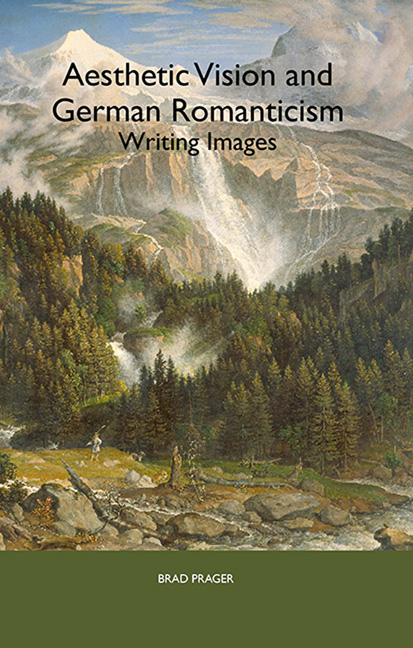Book contents
- Frontmatter
- Contents
- List of Illustrations
- Acknowledgments
- Introduction
- 1 Interior and Exterior: G. E. Lessing's Laocoon as a Prelude to Romanticism
- 2 Image and Phantasm: Wackenroder's Herzensergießungen eines kunstliebenden Klosterbruders, Tieck's Franz Sternbalds Wanderungen, and the Emergence of the Romantic Paradigm
- 3 Symbol and Allegory: Clemens Brentano's Godwi
- 4 Sublimity and Beauty: Caspar David Friedrich and Joseph Anton Koch
- 5 Light and Dark: The Paintings of Philipp Otto Runge
- 6 Absolution and Contradiction: Confrontations with Art in Heinrich von Kleist's “Die heilige Cäcilie oder Die Gewalt der Musik” and “Der Findling”
- 7 Self and Other: Joseph von Eichendorff's Das Marmorbild
- Conclusion
- Notes
- Works Cited
- Index
4 - Sublimity and Beauty: Caspar David Friedrich and Joseph Anton Koch
Published online by Cambridge University Press: 13 April 2017
- Frontmatter
- Contents
- List of Illustrations
- Acknowledgments
- Introduction
- 1 Interior and Exterior: G. E. Lessing's Laocoon as a Prelude to Romanticism
- 2 Image and Phantasm: Wackenroder's Herzensergießungen eines kunstliebenden Klosterbruders, Tieck's Franz Sternbalds Wanderungen, and the Emergence of the Romantic Paradigm
- 3 Symbol and Allegory: Clemens Brentano's Godwi
- 4 Sublimity and Beauty: Caspar David Friedrich and Joseph Anton Koch
- 5 Light and Dark: The Paintings of Philipp Otto Runge
- 6 Absolution and Contradiction: Confrontations with Art in Heinrich von Kleist's “Die heilige Cäcilie oder Die Gewalt der Musik” and “Der Findling”
- 7 Self and Other: Joseph von Eichendorff's Das Marmorbild
- Conclusion
- Notes
- Works Cited
- Index
Summary
Most attempts to place the work of Friedrich in context tend to focus on his Protestantism, his patriotism, his contempt for the French, and the reasons he was confined to his bed after Prussia's defeat by Napoleon in 1806. Friedrich's paintings from that period are in turn said to express “a desire for freedom based on a revolutionary return to a better past. While this may indeed be the case, I wish to put the larger European historical context in the background and focus on several formal components of Friedrich's style. Because analyses of Friedrich's work tend to involve questions of the dual aesthetic categories of beauty and sublimity, Friedrich, like Kant, is often described as having been fascinated by both sides of that aesthetic divide. On the one hand, his works recall the discourse of the beautiful, which is playful and expressly purposeless. On the other hand, they are seen as the sublime and therefore challenging response to any number of prescriptive eighteenth-century aesthetics of beauty. My aim in the following discussion is to show how the aesthetic distinction between sublimity and beauty reflects twin, philosophically inflected possibilities.
Sublimity, a truly Romantic tendency, sees the inner space of the subject as an abyss in which a conflict is waged that sets one aspect of the self against the other, particularly as it is defined by Kant in his Critique of Judgment. Beauty, conversely, marks the relation of self and world as a settled score; with respect to the discourses touched on in the present study, it appears as an anachronism. The two modes of understanding Romantic painting, namely, as either sublime or beautiful, reflect two aspects of the passage between Kant and Romantic aesthetics. In this chapter I examine how adopting Kant's approach sheds light on the confrontation with Romantic painting and offer up a contextualization of Friedrich's work by way of the specifically poststructural and, in some cases, politicizing positions of the theorists Jean-François Lyotard and Jacques Derrida. These contemporary arguments provide a formal basis for understanding why Friedrich's work can be described as sublime. As a counterexample I explore the way the same problem — the navigation of sublimity and beauty — is negotiated in the work of the painter Joseph Anton Koch.
- Type
- Chapter
- Information
- Aesthetic Vision and German RomanticismWriting Images, pp. 93 - 122Publisher: Boydell & BrewerPrint publication year: 2007



